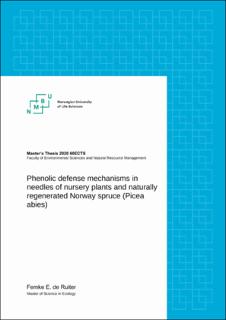| dc.description.abstract | To incorporate sustainable management in increasing forestry practices in Norway, low impact management of Pine weevils (Hylobius abietis), the most common pest on clear cut area in boreal silviculture, is of great importance. This project has looked at differences between inducible and constitutive defense mechanisms, comparing naturally regenerated and planted Norway spruce seedlings on a clear-cut area in Lomsdal, Eastern Norway under treatment with MeJA, Wounding, MeJA+Wounding. Chemical defense, specifically phenolics as well as to carbon, nitrogen, C: N ratio and defense related gene expressions were studied to investigate potential differences in defense mechanism between the two plant types by using HPLC, acid butanol assay, CHNS analyzer, and RT-qPCR. For single phenolic compounds, but not total phenolics, namely stilbene and Acetylphenone picein, as well as single flavonoids (+)catechin, gallocatechin dicoumaroylastragallin2, dicoumaroylastragallin3 and two unknown flavonoids differences for sample type could be observed. Differences in concentrations due to seedling treatment were true for insoluble condensed tannins, Dicoumaroylastragallin1 and dicoumaroylastragallin2. Trade-offs between defense allocation and growth could be one possible explanation for differences in carbon and phenolic concentrations between sample types. Additionally, or alternatively, seedling age, resource allocation to treated areas and UVB light exposure in early development could explain differences in defense composition. Gene expression analysis revealed possible explanation of higher concentrations of stilbenes due to a tradeoff between STS and CHS and CHI precursor use. This work has shown that differences between planted and naturally regenerated seedlings of Norway spruce (Picea abies) exist regarding carbon concentrations, C:N ratio, secondary metabolic compounds and gene expression. It can therefore be concluded that defense against external biotic stressors such as the pine weevil are potentially higher in natural regenerated seedlings which should be considered in future forest management to promote tree intrinsic defense mechanism. | en_US |

